A
web site dedicated to Keast Burke
Chapter three: Charles Bayliss
Keast
Burke's article on Charles Bayliss in the A.P.-R #7,
1953
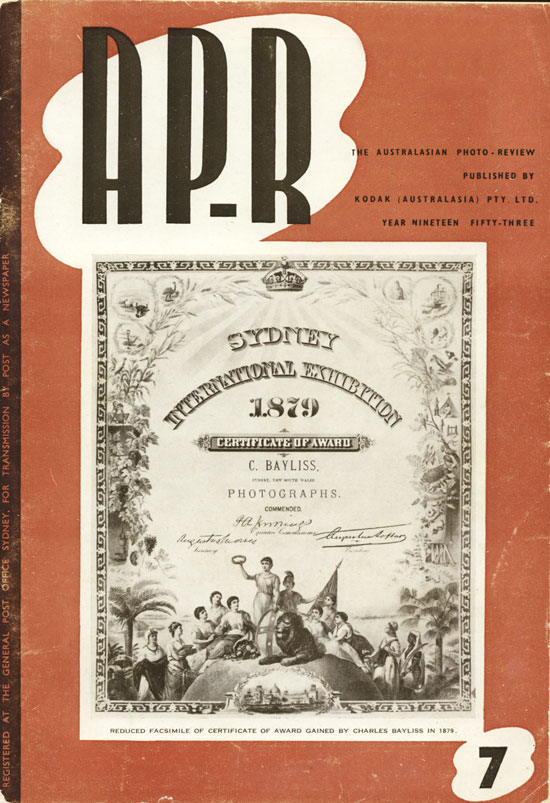
photographs copied from Gold
And Silver (Australasian Photo-Review #7 1953)
Gold and Silver
By Keast Burke
Chapter Three - Charles Bayliss
Grateful acknowledgment is made to Bessie Salier Patterson and Eric Edward Bayliss.
Our first word of Charles Bayliss goes back to 1854 when we hear of him as a child of four, with his parents, landing in Melbourne aboard a sailing ship from England, his birthplace having been in Hadleigh, near Ipswich in Suffolk - to this day, a quaint town of old-world houses.
The turning point of his life was to come to him at the early age of sixteen; surely there was something of the touch of destiny that brought to the gateway of his mother's home in a Melbourne suburb the wet-plate' caravan of travelling photographer Beaufoy Merlin. Young Charles, always old for his years, must have realised, in a flash, as it were, that he wanted to be a photographer and to learn the trade from his newly-found acquaintance with the friendly and magnetic personality.
For a lad to make such a decision is one thing but to gain a mother's consent is another. As we can well imagine, it was many days before she eventually gave way before his unending pleas. We learn of his duly joining up with Merlin as his assistant and of the pair going off to the "diggings" - which perhaps would be the Gippsland fields which rose to fame in the sixties. It was to be a year before his mother was to see him again; when he did return home he was a young man and one imbued with a deep love of Australia's great out-of-doors and more than ever convinced that photography meant everything to him.
The next year or so (c.1867-1869) embraced further field trips, one of which we know from the Manners-Sutton letter(1) to have been to the, Western District of Victoria. The association must have been a pleasant one for both of them. Merlin learnt to place the utmost trust in the young assistant who proved so apt and clever a pupil, while Bayliss was only too happy to be in the company of his mentor as the pair spent days and nights in the open occupied with their beloved photography.
The hour of parting was to come only too soon and it was destined to be forever. After nearly twenty years Merlin must have felt that he had pretty well completed the coverage as far as his particular house and residents type of photography in Victoria was concerned, and that fresh fields must be sought. It speaks volumes for his estimation of young Charles that he should have been satisfied to leave him in charge of his interests when he crossed the border northwards.
The story of Merlin's' photography in New South Wales has already been told; we have learnt of his great work for Holtermann and of his early passing, of how that wealthy man summoned Bayliss to Sydney with a view to bringing his immense enterprise to completion.
By early 1874, Bayliss must have been entirely engaged on the 'Holtermann project; some of the year's pictures were made in Sydney but the greater number represent Victorian subjects.
Of these quite the most outstanding is the great 9-exposure panorama of Ballarat, made from the tower of the Ballarat City Hall, photographed around about February or March(2). Both coating and exposure are perfect and so is the clarity of detail throughout; to make sure that there would be no vibration he arranged for the authorities to have the clock and its carillon (which had been installed during the previous year) stopped during the progress of the panoraming.
Next followed his photography on the 10" by 12" plates, these numbering about two hundred and ten(3); Melbourne is listed first with about 115 views, then Bendigo with about 30, Ballarat with 13 and Geelong with 10, to say nothing of odd scenes at Stawell, Castlemaine and elsewhere-in all a most comprehensive coverage. The individual identification of these has barely been commenced but already one point is quite clear - that all are marked by first class technique and that all would enlarge splendidly; perhaps some day they will be, when there has been settled the practical, problem of an available 10" by 12" enlarger.
The highlight of the following year was the making of giant. Sydney panoramas; so unique a project may well have taken several months. The period was almost certainly during the late winter and early spring, for the successful completion received some newspaper publicity during October while, in addition, we have the evidence of the Commodore Goodenough funeral picture(4).
Work for the year 1876 included a number of Melbourne views made in the 18" by 22" format, a size decided upon perhaps because 20" by 24' represented the largest size in which the albumen printing paper was readily available; subjects included The Bank of Victoria, Scots Church and the not-altogether-successful panorama from the tower of Government House in the Botanical Gardens. In addition, Bayliss would have spent a good deal of time in Sydney printing, assembling and mounting the material destined for exhibition at Philadelphia, as well, there would be the great roll of prints which Holtermann was to take along with him for display en route.
An 1876 negative of especial interest appears to be a record of the opening day of the extension of the railway to Beechworth (Victoria); if so, this photograph may be accurately dated to September of that year. The picture may well represent Bayliss' last exposure on behalf of Holtermann and so take us to the threshold of his work as an independent photographer, for two years later we hear of him and his set-up moving permanently to Sydney.
His home was in the western suburbs and his place of business, as shown in Sands Directory for 1879, was at 348 George Street. This would be near the corner of Angel Place. (Some years later he moved across the road to No. 335A).
We do not know exactly what was the appeal which brought Bayliss to Sydney. It may have been some act of encouragement or generosity on the part of his wealthy sponsor; on the other hand his interest may have been stimulated by hints of the untold glories of the forthcoming Sydney International Exhibition of 1879.
Meanwhile, he lost no time, after setting up his brass plate as "Charles Bayliss, Landscape Photographer", in commencing to get together a large collection of stock negatives of all the 'best sellers' of the day(5), street scenes and public buildings, the harbour and its shipping, the (empty!) beaches, the beauty spots of the Blue Mountains and so forth.
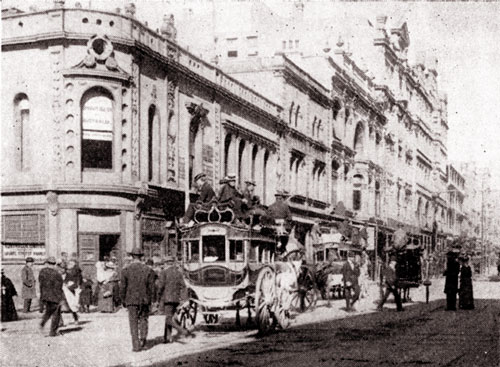
The east side of George Street, Sydney, looking south from the King Street intersection.
And now it is 1879, the year of the opening of the Sydney International Exhibition in the "Garden Palace", a vast structure of ornate design, situated in the Botanical Gardens (facing central Macquarie Street), just inside the Hunter Street gates. The organising genius of the enterprise was one Jules Joubert and it would take a full dozen A.P.-R.'s to reprint all the eulogistic contemporary descriptions of its many 'marvels'. More important to us today is the fact that it did inspire two lasting achievements: It inspired Henry Kendall to write a fine prize-winning ode(6); it also inspired Charles Bayliss to undertake and to carry through to completion one of the world's most difficult photographic undertakings, that of executing a complete panorama from the 'lantern' of its dome.
As noted in current newspaper reports this spot was accessible from the interior of the building during the period of the construction of the building but once it was completed the ascent had to be made from the outside. So it was that, to obtain his panorama, Bayliss "had to perform the astounding and risky feat of climbing up and balancing upon the dome of the tower"(7). The finished panorama was all that could be desired; "the result of his labours constitutes the best panorama of Sydney we have ever seen. The work of art to which we allude consists of a series of pictures taken on 18" by 22" plates, forming an extensive representation of the city and its suburbs, measuring 20 feet in length by 22 inches in breadth. As a specimen of photography it is almost faultless . . . the clearness and completeness of the picture is surprising.
There is some probability of the panorama being placed in the Exhibition, and it is decidedly to be wished that an opportunity may be given to the lovers of beauty in art to see this, the cleverest work, that has for a very long time issued from a colonial gallery". Though panoramas of Sydney can hardly be said today to appeal "to the lovers of beauty in art", nevertheless this series of pictures must represent a most valuable record of the condition of the city's growth at that time.
Some six or seven months later, Bayliss secured another picture(8) of the "Palace". This time it was from the eastern side of Farm Cove, just after the Exhibition had closed and, incidentally, just after the completion of the harbour wall around the Cove. It was another link with Kendall for it was here that the poet used to walk in the period 1866-1876 on many an afternoon at the conclusion of his labours with the Government Surveyor and the Colonial Secretary. For a number of years afterwards a rock near Mrs. Macquarie's Chair was pointed out as "Kendall's Rock", and this spot must have been very close to the viewpoint selected by Bayliss for his photograph some fourteen years later.
But there was one "Palace" photograph which Bayliss unfortunately did not capture though he would most certainly have done so had he been passing down Macquarie Street in the very early morning of 22nd September, 1882. For that was the day on which the great structure was burnt to the ground(9).
At the ensuing enquiry "carelessness with matches" was suggested, or, at any rate, "rats nibbling at vestas", but the more cynical opinion favoured the suggestion of arson-this at the instigation of some person or persons unknown who might well have liked to know that the contents of the building (then used as a repository for old government records) were safely reduced to ashes. No one was heretical enough to say that the 'arson' might have been at the hands of some lover of beauty who considered the massive structure to be a blot on the beauties of the gardens and of the harbour foreshores!
As to the fire, the journalists of the day found in the event something that provided the fullest scope for their descriptive powers(10).
Meanwhile, Bayliss was carrying on with his various commercial assignments and with his stock views of Sydney. About this time he appears to have developed something of a "news" or documentary outlook, especially with regard to buildings under construction, and it is to this trend that we owe a number of fine pictures.
Three of these are reproduced - we see the master mason at work on one of the columns of the Pitt Street wing of the G.P.O. (mid-1882); the workmen putting the final touches to the great dome of the Queen Victoria Buildings (c.1897); and, most interesting of all to our (lamenting) Sydneysiders, the G.P.O. clock tower under construction, with Sir Henry Parkes and officials paying a state visit - this would be towards the end of 1885.
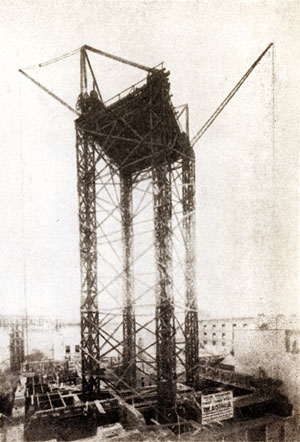
Foundations and elevated cranes for the building
of The Australia Hotel (Castlereagh Street
frontage, c.
1891).
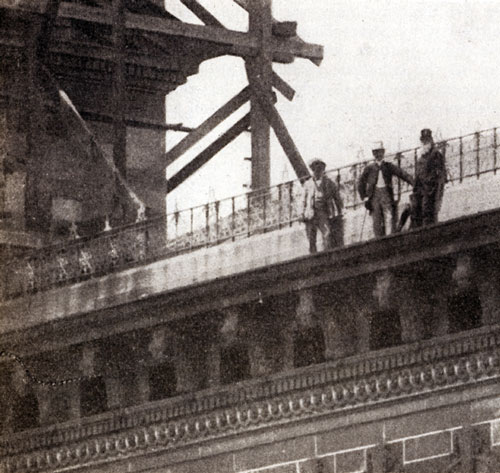
Sir Henry Parkes (r.) pays an official visit to Sydney's G.P.O. tower under construction; the date would be towards the end of 1885. (Enlarged detail from the full-page portfolio reproduction.)
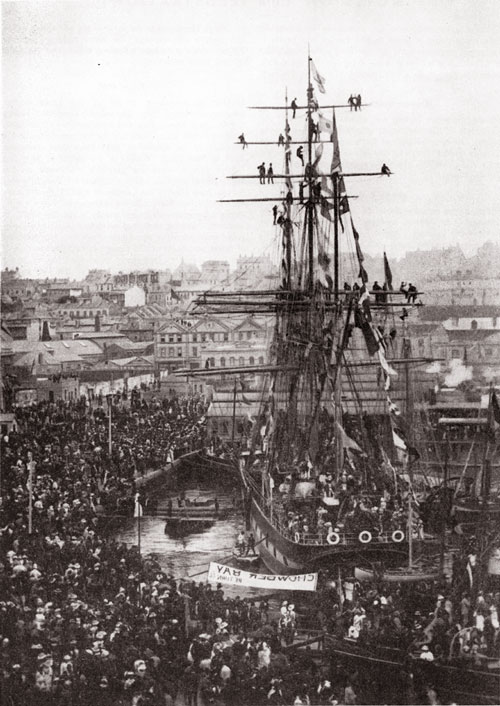
That
year, 1885, was responsible for two other
fine series of documentary records.
March
3rd saw the embarkation of the Australian
volunteers for the Sudan aboard the troopships
Australasia and Iberia. It
was an occasion for a tremendous outburst
of national pride and, in those happy
days before the onset of 'security',
the photographers had a field day.
Bayliss
not only photographed the troops but
he also recorded the animated scene at
Circular Quay where civilians were boarding
every possible type of craft for the
trip to Chowder Bay and other harbour
vantage areas from which, a farewell
could be paid as the ships passed through
the Heads(11).
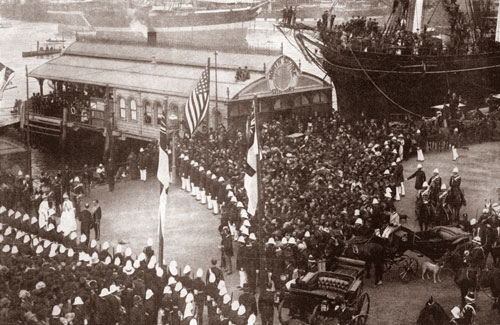
Nine
months later, on December 12th to be
exact, he was again down with his camera
at Circular Quay for another important
occasion it was the arrival at the Prince's
Steps(12) of
the State Governor-elect His Excellency
Baron (later Lord) Carrington together
with his wife and the Hon. Miss Harbord.
This
picture turned out excellently with plenty
of local colour in the shape of waiting
carriages and the excited populace, elements
of which are seen to have climbed to
the topmost rigging of the P. & O.'s
Dharwar, most conveniently moored for
the purpose.
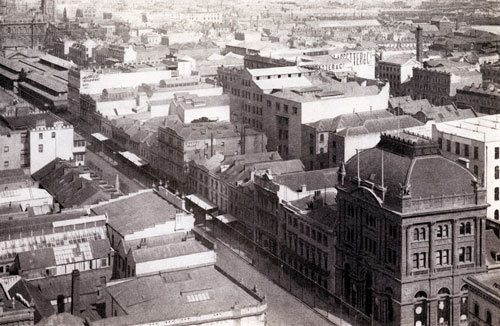
The
following year was marked by yet another
Bayliss 'scoop' - the making of the first
360° panorama from Sydney's G.P.O.
tower, now completed, yet destined to
remain clockless until September 1891.
Like
its "Palace" predecessor the
panorama is a magnificent technical,
job with every one of its frame's' depicting
respective sections of the city's buildings
with a clarity that could hardly be equalled
today.
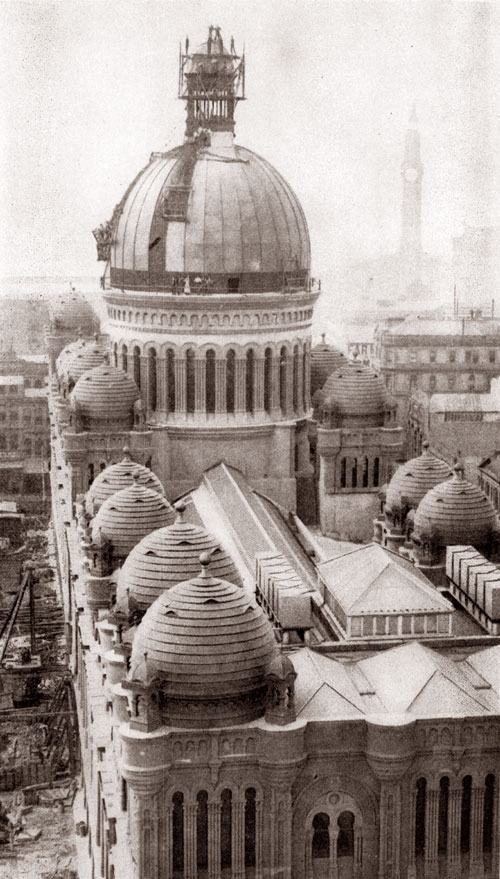
It
is a fascinating picture to study and
thereby appreciate the changes that have
occurred in nearly seven decades. In
those days for instance, the hall portion
of the Town Hall was still a-building;
there was no Queen Victoria Markets;
the roof of Her Majesty's Theatre was
uncompleted;we had no 'Australia' or
'Metropole'; and the plinth at Queen's
Square stiR lacked its bronze Queen ('she'
was to be unveiled in 1888)-this was
the second statue, the earlier one having
been destroyed in the "Garden Palace'
holocaust.
------------- ------------- -------------
A documentary picture of considerable value from the aspect of railway development is one taken at the site of the original Hawkesbury River Bridge. This photograph, made about the middle of 1887, shows some of the piles in position and in the centre foreground the paddlesteamer which was used to convey passengers across this unfinished link in the railway system northwards.
The eighties were almost certainly a busy period for Bayliss, though the details lack full confirmation. There is the suggestion that he visited Tasmania and New Zealand, there photographing the famous pink and white terraces. If the N.Z. trip is confirmed it must have occurred prior to that tragic day of June 10th, 1886, when this glorious natural beauty was engulfed in thirty feet of volcanic mud.
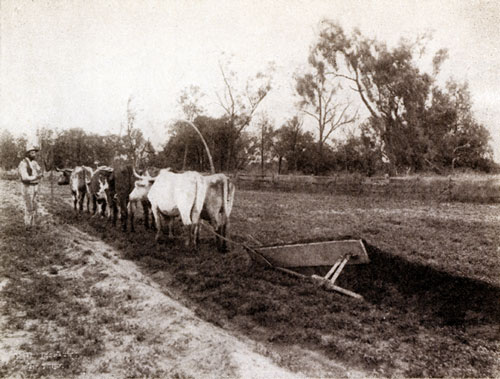
Road-making operations on the Donkin property at Lake Cowal (N.S.W.). This photograph is reproduced by way of representation for the photographer's many up-country assignments.
His most important assignment of this period was to accompany, as official photographer, the Royal Commission on Water Conservation, instituted in 1886 by the N.S.W. Government to travel the Darling from Bourke to Wentworth. One Commissioner was J. B. Donkin, a man of great enterprise and initiative, who not only secured the services of Bayliss as photographer but as well invited Gilbert Parker, (later Sir Gilbert Parker, the distinguished Canadian man of letters, then on the literary staff of The Sydng Morning Herald) to accompany the party as historian(13).
The Bayliss photography on this occasion, as ever, was first rate and three fine examples have been selected for reproduction.
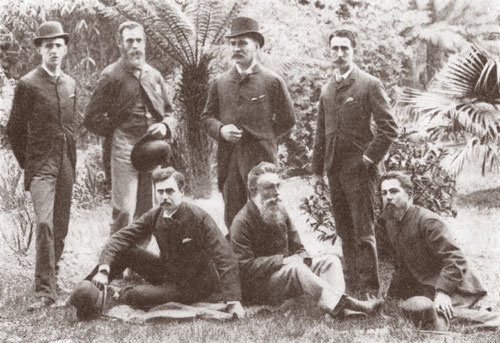
Group photograph taken in the Fitzroy Gardens, Melbourne, at the conclusion of the Royal Commission on Water Conservation trip. Gilbert Parker is seen seated (on left), Charles Bayliss (right), and J. B. Donkin standing (third from left).
In 1883 he married Christiana Salier. There were tobe seven children of the marriage, five sons and two daughters.
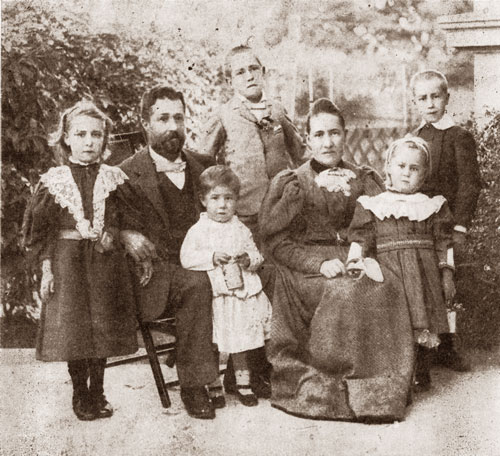
Charles Bayliss and his family, photographed about the middle of 1895.
The children, from left to right, with years of birth;
back row: Raymond Charles (1884), Alfred John (1886);
front row: Bessie Salier (1888), Walter Norman (1893), and Emily Annie (1891).
Alfred and Walter lost their lives in World War One.
Eric Edward Bayliss was born subsequent to the photograph (1896), while Charles (1887) died in infancy.
The early nineties are marked by some good family pictures accurately dated to Feb. 22nd, 1891. They show some of the children at play, on a sturdy seesaw and on a dummy coach-these constructed as gifts no doubt for the previous Christmas. All accounts refer to his great love and affection for his young family. For them there could be no worse punishment than a severe look from their father. Apart from that occasional "severe look", all recollections are of a happy father, and of one who was forever adding to that happiness touches of whimsy(14) that could not but charm his wife and his young sons and daughters.
Another important project of the nineties(15) was his photography of almost every important oil painting in the National Art Gallery of Victoria - a large volume of prints contains scores of these copies. These are all so perfectly rendered as to make us wonder whether or not Bayliss had some private means of improving the sensitivity of his colourblind plates, for orthochromatism, is not quite the novelty we have always been led to believe(16).
As an example of this National Gallery work, we have selected Louis Buvelot's picture Waterpool at Coleraine, this partly for the reason that it appears to be the best Australian painting, and partly because Buvelot was "the first artist of note to set down in terms of paint the atmosphere of the Australian bush"(17).
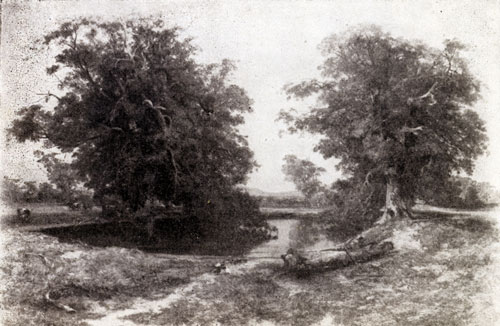
Waterpoo at Coleraine, from the painting by Buvelot, as copied by Charles Baylis. This was one of a large number photographed in the early nineties from the collection of the National Gallery of Victoria.
From family tradition we learn that Charles Bayliss was one of the earliest process-engravers in Sydney and that he made the illustrative plates for the Sydney Mail of that period. Of this there is no proof beyond. the circumstantial evidence that certain issues (June 22nd, 1895 and September 5th, 1896) refer respectively to "illustrations produced by various new processes" and "great advances [which] have immensely popularised certain forms of pictorial art". This evidence is supplemented by the tradition that "he had men continuously engaged on making blueprints and on other work for architects and engineers" and by the, fact that his eldest son adopted process-engraving as his trade.
On one early winter's day in 1897 Charles Bayliss arose early, as was his custom, to feed and harness the pony which he drove each day from his home in Marrickville ("Hadleigh" in Wemyss Street) to his place of business. His powers of resistance must have been low for he caught a chill which swiftly turned to a "galloping pneumonia", in those days, the equivalent of a sentence of death.
On June 4th, at the untimely age of forty-seven, he passed from the ken of his family and of a very wide circle of friends. "As a man he was ever genial and kindly; as a landscape photographer he had few equals and no superiors. His memory is forever honoured in the hearts of all who knew him."(18)
Today Australia must honour the memory of Charles Bayliss for a major contribution to photographic Australiana; without his encouragement, infectious enthusiasm and practical photographic ability, Holtermann might very well have come to lose interest in those very involved photographic plans of his.
Footnotes
- Printed in THE A.P.-R. for March; 1953, p. 142.
- A section of one of the exposures was reproduced in THE A.P.-R. for March, 1953.
- It is unlikely that all of the Victorian series would have been made during the one year.
- Vide EVENING NEws (Sydney) for Oct. 22nd, 1875, also THE BRITISH JOURNAL OF PHOTOGRAPHY for July 7th, 1876. The Commodore Goodenough funeral was on August 24th of the same year. Incidentally the Commodore's widow had a church bell cast in her husband's honour, and either by accident or design this bell came into the possession of the Melanesian Mission at Norfolk Island, where it still remains. (H.J.R.)
- The sale of scenic prints was an important part of the livelihood of the outdoor photographers of the day-see THE A.P.-R. for 1952, p.410
- The prize which Henry Kendall won was for the one hundred guineas offered by THE SYDNEY MORNING HERALD. The ode, together with another. in connection with the subsequent Melbourne Exhibition, is included in most volumes of his collected works. Three lines of descriptive interest are quoted:
- " What dream is this on lawny spaces set? What miracle of dome and minaret What great mute majesty is this that takes the first of morning ere the songbird wakes."
- The quotation is from THE A.P.-R. for the year 1897: As there were eleven (presumably wet plate) negatives in the big panorama, we must hope that there was a manhole in the floor of the great 'lantern'-it was twenty feet in diameter and thirty seven feet high-through which the large 20' by 24' dark slides could have been hoisted from the hands of the coating assistant; eleven hazardous ascents and descents would surely have been out of the question. The feat of "balancing upon the dome" must also be questioned.
- Reproduced in the portfolio.
- As we write, we have had the pleasure of interviewing two friends who were eye-witnesses of the great conflagration. The first of these was R. A. Broinowski whose family was at that time resident at 171 Macquarie Street, one of the old houses which still survives.
- He writes: "As it was growing light I was awakened by one of my brothers saying 'The Garden Palace is on fire. My bedroom window overlooked the entrance to the Botanical Gardens, and just beyond the great building of the Exhibition loomed through slowly rising smoke. The sun was rising, and his rays were challenged by a line of fire running along the roof, and here and there breaking through. Down below a man was running madly carrying a ladder. Then the nearest tower of the building was suddenly enwrapped in flames, and the fire brigades could do nothing. Tower after tower fell with mighty crashes, with masses of debris and roaring flames shooting into the sky.
- Gradually the flames spread to the dome, which crashed into the inferno with a terrific roar. That was the climax!" The final crash of the great dome is also well remembered by H. J. Rumsey, whose people at that time lived at North Sydney; they were awakened by the milkman on his early morning rounds.
- The scene would have been magnificent at night time, and even in the light of day it was grand. The flames were sometimes tempered carmine, green, yellow, or blue, by the burning of the galvanised roofing, and the various metallic substances contained in the building, and the heat from the conflagration was so great that at five minutes past six o'clock, or 25 minutes after the first alarm was given, the glass in the windows of houses in Macquarie Street began to crack. . . . The terraces and high balconied houses in Macquarie Street presented quite a carnival appearance. In every balcony was a group of people, some of the members clad in dressinggowns, others hurriedly robed in the costumes that came first to hand. Even upon the tops of the houses were spectators. Along the line of footpath clustered men, women, and children, all quiet and absorbed in the sight; and, as the flames took fiercer hold upon the building, and the heat increased, they hurried away with their hands shading their faces. When the fire was raging in its greatest strength, the sun was seen behind the burning Palace through the haze of smoke rising above the horizon its crimson disc. The scene was the most imposing, as it was the most pitiful, ever seen in the colonies." (ILLUSTRATED SYDNEY NEWS) Other famous fires in Sydney have included; the Prince of Wales Theatre (October 1860); the great Hoskins Place fire (October 1890); and Anthony Hordern's (July 10th, 1901).
- "Out of the main streets the crowd of people came hurrying into Phillip Street, Young Street, and Castlereagh Street, whence they proceeded in thousands into one surging mass which gathered in Albert Street at the Quay. . . . The order issued by Inspector -General Fosbery, warning women and children to keep away from the crowd was of course strictly disobeyed. Several women had their garments torn, and,were with difficulty rescued from the crowd again. A number of unruly characters made their presence felt, and by roughly pushing people intentionally made matters worse than they would otherwise have been. Casting a glance round on whatever side, it was the same-people. People in thousands, crushing'and pushing in their excited desire to gain some vantage ground . People in every window and door, and on every roof where there was standing room, until the buildings themselves seemed almost shut out from view. People on every vessel around the harbour, perched away high up on the trucks, standing out on the yards, crowding the decks, or peering out of port-holes. . The scene in the harbour was one of extreme beauty, and the effect of it was- heightened as the troopships stood away from the wharfs, when every portion of their structure, every rope and waving flag and pennant, stood out sharply against the background of shore and sky, while the men, posted in the rigging to obtain one long last glance of home, formed striking figures in the picture." (AUSTRALIAN PORTRAIT GALLERY, Vol. 111) (W. M. McClardy, Printer).
- So named in honour of Prince Alfred (1870). It was also used by the 'young princes', Prince Alfred Victor and Prince George of Wales (August, 1881), The arrivals of the various State Governors-elect were important events in those days and were marked by scenes of tremendous public enthusiasm. Actually Baron Carrington had arrived in the liner Carthage on the previous day; the state landing was made from the government launch Ena following on a short tour of the southern side of the harbour.
- Five years later, Gilbert Parker, in his book 4ound the Compass in Australia, wrote very fully concerning his trip with the Royal Commission. From his account we have extracted some initial paragraphs:
- " It was my good fortune to receive an invitation to travel in their company, since I was going in their direction. Because of this I altered my plans somewhat and determined to follow where they led. Royal Commissioners, Mr. J. B. Donkin, Mr. F. B. Gipps, the Secretary, two reporters, a photographer and myself constituted the party. We seven looked out upon Bourke one Sunday evening as it rose from the scrubby plain and eyed apprehensively the Darling, which was aflood, and debating whether to rise four inches more and cover the streets. Had it done so, portions of Bourke would have been floating down towards Barrier Ranges as they did the other day. There would be little use in banking because the surrounding country is flat, and if the river overtipped its banks at all, there would be no salvation for the town. Fortunately the stream decided otherwise and its feeder, theWarrego, also stopped its outflow in time.They embarked on a little paddle steamer called the Florence Annie and a journey of three weeks down the river Darling towards Adelaide began.
- " The Florence Annie was a paddle wheel craft, such as did duty in the early days on the Mississippi and she had just such a task.
- "It is no labour of ease to navigate the Darling river which winds its devious way for 2000 miles. A few miles below. Bourke the Darling was no longer the Darling but the Nile, flooding the country for miles on either side. The channel.wound between lines of ragged, gnarled and almost shadeless gum trees. It was the custom of the Florence Annie to tie up every night, and if near a station the seven [travellers] would repair to study water conservation and land conditions by taking evidence from the squatters, and during the day it was also the habit to stop at every station with this end in view. A man with half his sheep -run under flood should be able to speak to some purpose on the conservation of water." (FROM THE COPY IN THE MITCHELL LIBRARY, SYDNEY.) (The party left Sydney on 18th Sept., 1886.)
- Very much in evidence in his letters to his family-especially in the letter to his wife of Dec. 30th, 1896, when she and the children were holiday-making at Thirroul.
- Fortunately dated by the inclusion of a copy of a humorous pen-and-ink sketch by Du Maurier dated in his own writing to September, 1891.
- Vide BRITISH JOURNAL ALMANAC for 1878, in which a contributor recommends chlorophyll and other dyes for the purpose of extending the range of colour sensitivity.
- "Buvelot (1814-1888) belonged to the Australian School of Painting. He was born at Morges, on Lake Geneva, the son of a postal oifficer. Studied at the Lausanne Academy, and under Wolmar. Leaving Switzerland in 1834, he worked under Flers in Paris, proceeding thence to Brazil. After 18 years in Brazil, returned to Europe, where he met with success, but unable to stand the severe winters of his native country, migrated to Australia, reaching Melbourne in 1865. By 1869 his work had attracted attention, and his first three Victorian landscapes were purchased for the Melbourne Gallery. Buvelot was the first artist of note to analyse and set down in terms of paint the natural characteristics and atmosphere of the Australiarf Bush. He may thus be counted the forerunner of the Australian School of landscape painters. The influence he exercised has been recognised by the naming after him of one of the Galleries in this Institution". (Biographical note-Catalogue of the National Gallery of Victoria, 1948.)
- Excerpt from his obituary, THE A.P.-R., 1897.
APR Photographs
Grateful
acknowledgment for permission to reproduce these illustrations
is made to Eric Bayliss and Bessie S. Patterson, respectively
the sole surviving son and daughter of Charles Bayliss.
There is one exception: for the G.P.O. panorama picture
we kindly thank J. V. Hall (of Sydney).
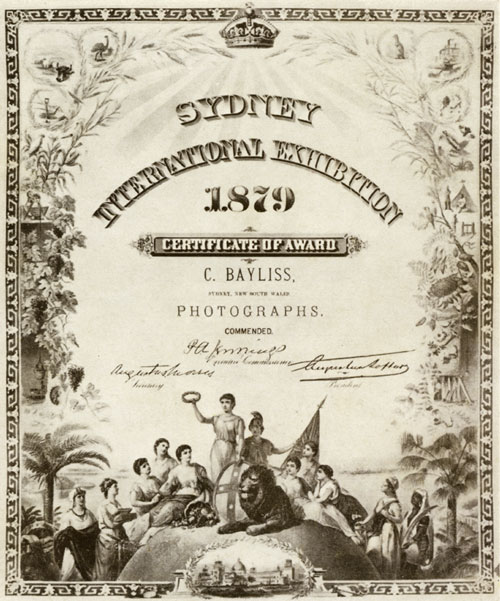
(Cover Illustration)
Reduced facsimile (actual size about 16' by 20")
of the Certificate of Commendation gained by Charles
Bayliss at the Sydney International Exhibition
of 1879. In
the circular wreath design at the foot there can be seen an artist's sketch
of the exhibition building as observed from the
south-west.

The animated crowd gathered at the south-east corner of Circular Quay, Sydney, on March 3rd, 1885 in order to farewell the volunteers bound for Suakim in the Sudan; from this area many small craft went out to the Heads in company with the two troopships. The barque in the foreground is the "Scottish
Bard".
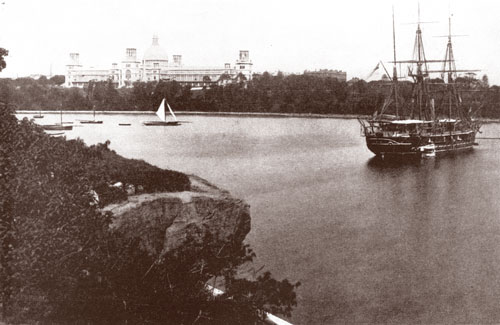
Farm
Cove, Sydney, showing the Garden Palace erected along
the Macquarie Street frontage.
The man-o-war
in the foreground is either "Espiegle" or "Cormorant".
The photograph was probably made some short time after the completion
of the harbour wall in May, 1880.

The official landing of His Excellency Baron Carrington
on December 12th, 1885 at Prince's Steps, central
Circular Quay, Sydney.
The
steamer shown
is the "Dharwar" but
the reason for the prominence given to the 'Stars and Stripes'
has not as yet been elucidated. (Photograph identified by A.
J. Perier).
('Same-size' detail from the 10" by 12' original).
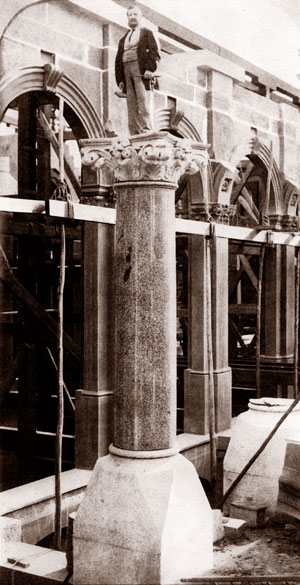
The master stonemason (and clerk of works), believed
to have been John Howie, at work on a pillar
of the Pitt Street wing
of the
G.P.O., Sydney,
about
the middle of 1882. Today the pillar can be readily identified
through its characteristic
marking by anyone who likes to stroll along the great colonnade.
This section of the G.P.O. appears to have been finished
in 1883-that is,
about thirteen
years after the George Street portion; the latter's facade
once upon a time carried
a "completion stone", engraved with the figures
1870, on one of its uppermost panels.
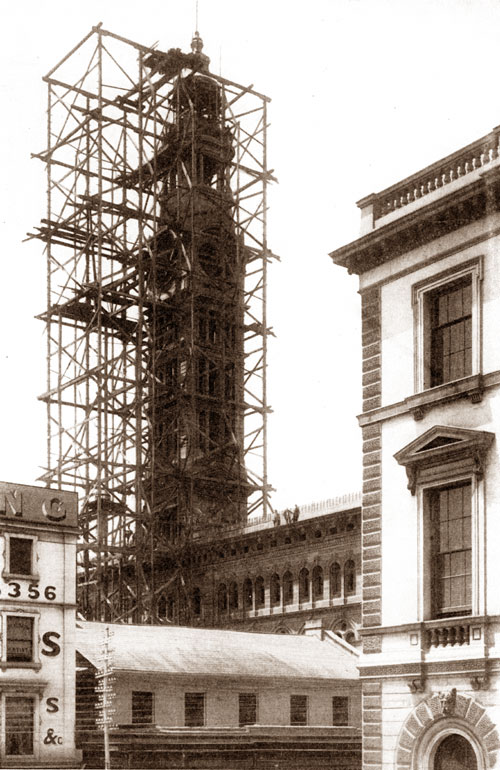
The tower of the G.P.O. (Sydney) under construction,
towards the end of 1885. The group of figures
includes Sir Henry
Parkes (who
had somewhat
unsuccessfully
endeovoured to resign from politics some little time
previously as a mark
of his disapproval of the Sudan venture).
The more
adventurous youth of the period
(and this included A. J. "Mons" Perier) used
to scale the tower scaffolding (by means of the cross
pieces of the
north-east vertical) for the purposes
of having lunch two hundred feet above the streets
of Sydney.
Bayliss' own rooms
were in George Street just to the north of the point
from which this
picture was exposed. The other buildings, besidesPalings,
are the Railway's Booking
Office and the Bank of New South Wales.

Looking south-west-a section of the great Bayliss
panorama exposed from the recently-completed
Sydney G.P.O. clock tower. This was photographed
about April, 1886, the date
being confirmed by the completion of the premises of the Australian joint
Stock Bank (now the
Bank of New South Wales) at the corner of King and George Streets.
Note the
glazier's whitewash on the newly-glazed windows.
Items of interest are the scaffoldingfor
the Town Hall ("The Centennial Hall"), the old markets, and across
Market Street to the north, Tuttle's sign, Tuttle's being a well-known studio
in its day while, in addition, it coated sensitised materials. (A similar photograph
made some five years later shows the early premises of Baker and Rouse at 375
George Street).
The doorway of' the Bank premises (not shown very clearly owing
to the shadow) is worthy of personal study; the two marble figures represent
'Justice' and 'Plenty' while the doors themselves are made of iron richly ornamented
with bronze decorative mouldings culminating in relief medallions of St. George
and the Dragon.
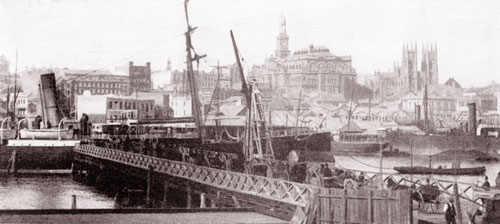
Horse-drawn vehicles in a traffic hold-up on the old wooden Pyrmont Bridge-this
apparently due to an A.U.S.N. vessel being eased through owing to the narrowness
of the swinging portion of the bridge.
In the absence of any intervening buildings
the majestic proportions of the Town Hall and of St. Andrew's Cathedral can be
fully appreciated. Work on the new Pyrmont Bridge was commenced in 1889.
All three landscape photographs were made during the progress of the 1886 Royal
Commission on Water Conservation as it travelled the River Darling from Bourke
to Wentworth.
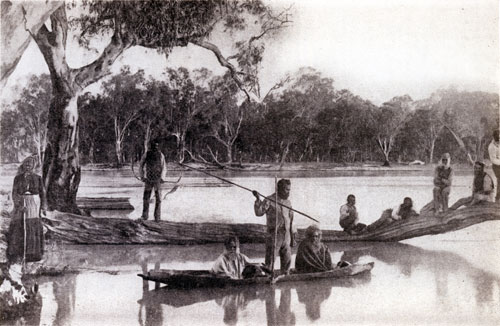
The
photograph of the aboriginal group is interesting as
typifying the 'artistic posing' that was popular'at
the time.
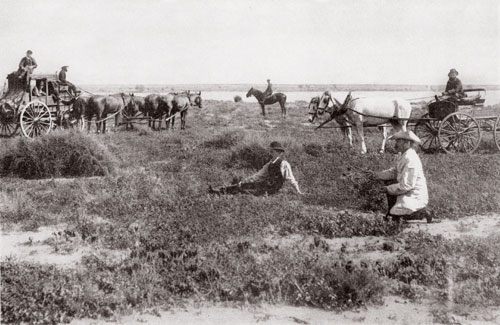
The
scene on the great plains is believed to have been
made in the neighbourhood of' Wilcannia;
the figure to the right in white clothing is J.
B. Donkin, a Commissioner, while the foreground
vegetation represents a fine display of Sturt's Desert Pea in full
flower.
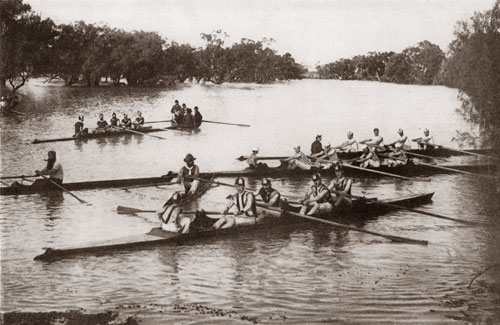
The
regatta subject is thought to have been made at Horseshoe
Bend between Wentworth
and Mildura and some of the crews are believed to be wearing
the colours of some of the Adelaide clubs of the
day. A
point to
note is the flooded state of the
river system, as emphasised by Gilbert Parker perhaps
it is due to the waters of the Darling holding up the
mainstream,
a fact which would account for the
surprising absence of turbulence.

We see the finishing touches being made to the dome of the Queen
Victoria Markets as we look north along the York Street facade
from the roof of the Town Hall.
As the building was completed during 1898, this may well have been
one of Bayliss' last photographs.
Return to APR Introduction Page